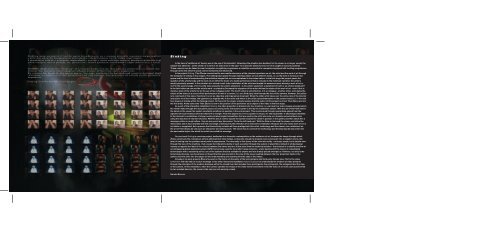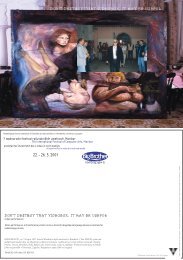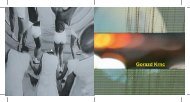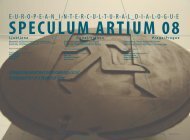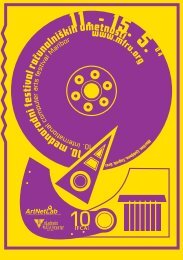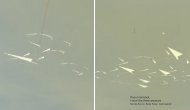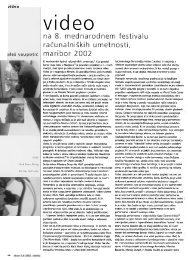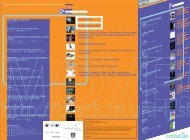Untitled - ArtNetLab
Untitled - ArtNetLab
Untitled - ArtNetLab
- No tags were found...
Create successful ePaper yourself
Turn your PDF publications into a flip-book with our unique Google optimized e-Paper software.
SinkingIn the time of traditional art 'beauty was in the eye of the beholder'. Nowadays the situation has doubled, for the viewer is no longer merely thesubject that observes - as the viewer of a work of art used to be in the past - he is also the observed one, for he is caught on security cameras.These cameras can be linked to smart computer recognition programmes or satellites connected to computers equipped with locating programmesthrough which the viewer's space can be monitored and influenced.In his project Sinking, Tilen Žbona researches the new media extensions of the classical questions on art, the artist and the work of art throughthe metaphor of sinking in four stages. The sinking takes place through watching videos on two different levels, i.e. on the level of moving in realspace and the level of understanding the individual stages that are conceptualised in four video haikus. In the first stage the project poses thequestion of the artist's body and the work of art within the frame of a media performance that is reduced to the minimum narrative: the artist ismerely physically present. Is the situation of a closed circuit video installation of the artist and maybe his excessive move already a work of art ornot? In the second stage of Sinking the video presents the artist's statement - is the artist's statement a statement of truth or an artistic statement?In the third video we can see the artist's work - as stated by Duchamp the signature of the artist defines the status of the work of art - even if this ismerely a mark of the artist's fist on the eye of his colleague artist. The fourth video is self-reflective. In it a colleague - another artist - articulates thenature of the video as a record of the performance in front of a camera, i.e. as a third party view through the lens of the camera. However, the authoris in command of this video, therefore it is not an objective and impersonal document. When the other artist takes over the active role of the directorand author of all four videos, the questions as regards who is the artist and where is the artist repeat themselves in the second round, i.e. in the nextfour stages of sinking within the Sinking project. At this point the viewer actually realises that the author of this project is in fact Tilen Žbona and notthe first artist. At the same time Tilen Žbona is now in the position of the performer as an object of the video in the first stage.As a part of the interactive installation Sinking, the video projection is divided onto four monitors, i.e. we have four video images amongst whichthe viewer walks through the real gallery space according to the instructions given to him by the installation system. With the aid of the Palm held inthe hands of the viewer the system constantly monitors his position in the environment. This is performed through spatial data gained from thesignals from local wireless networks that form a triangle. From this aspect the Sinking system is unique, for 'the big brother' is shockingly simplifiedto the domestic constellation of cheap nearby wireless signal transmitters that are used by the artist who acts as a friendly nomad without evenusing the data flow of internet networks. With the aid of control signals the system locates the viewer's position in the gallery and then sends him amessage written in rough letters - they do not permit any discussion: 'Go to the left back part.' With the Palm in his hand the viewer can follow theinstructions and is thus awarded with the next stage of sinking into the reflection of an interactive installation. Because the new media work of art isnot static or completed, but a process that interactively includes all three protagonists (the artist, technology and the viewer) can a statement onthe art of Tilen Žbona be only such an interactive and sinking work. The viewer has to confront the technology and thereby step-by-step enter intothe new media object into which the artist has coded his message.On one hand Sinking is a serious project, dedicated to a theoretic contemplation on the existence of art; however the image through whichŽbona constructs the conceptual, almost philosophical video haikus, is obscene enough to sharpen every conclusion into a negation and a newlevel of sinking into the problem merely with its appearance. The obscenity is that leaver of the view into reality - no longer single, but a double viewthrough the view of the machine - that reveals the inherent brutality of such a position through the system of algorithms robbed of all ideologicalnaivety as regards the ideal of the contact between the viewer and art. At the same time the technical solution - that instead of a satellite and the allencompassing global positional system (GPS) humorously uses the local short range networks - starts dealing with the issues of complicatedtechnologies with a surprising ad hoc use of the systems that are available to anyone and are already placed amongst us. However, not only is thetechnology obscene, we should also not forget that this was and still is the view of the viewer walking between the four projection fields in thegallery and who sinks into the stages of mis/understanding and rejecting what he sees in the videos.Already in his early projects Žbona focused on the theme of obscenity of the technological and third party human view. First in the videoUnheimlich with the help of scratch montage. In the other interactive installation Hybrid Subjects he understands the medium of video primarilythrough the principles of the medium dialogue within the closed loop that includes three participants: the protagonist, the antagonist and the viewof the camera. In this installation, when the camera catches the image of the video viewer and enters it into the video of an erotic dance performedby two masked dancers, the viewer is the only one not wearing a mask.Narvika Bovcon


